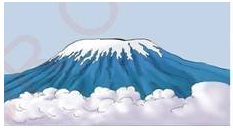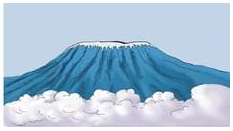Chapter 01 : Hazards associated with environmental destruction
IntroductionIn Standard Five, you learnt about activities that can lead to environmental destruction. These activities include agriculture, livestock keeping, charcoal making, mining, and industrial production. If these activities are done without following environmental laws and regulations, they may cause environmental destruction. You also learnt about the effects of environmental destruction. In this chapter, you will learn about the concepts of climate change, global warming and the relationship between human activities and global warming. You will also learn about the relationship between hazards and global warming, the effects of global warming and strategies to deal with them. Likewise, you will learn about ways of controlling environmental destruction. The acquired knowledge and skills from this chapter will help you to carry out your daily activities without negatively affecting the environment, hence avoiding hazards. They will also enable you to identify ways of avoiding environmental destruction and managing hazards.
Remember
|
The concept of climate change![]()
Climate is the average weather conditions of a place observed and recorded over a long period of time, usually 30 years or more. For example, temperature and rainfall are important elements of climate. If an area is known to have an average temperature of 250 C and an average annual rainfall of 1 000 mm, it means those conditions are average records of 30 years or more. If the average conditions change significantly after the period of 30 years or more, then the condition can be termed as climate change.
It is important to know the climate of a particular area because it shows long-term trends in the elements of weather such as rainfall, temperature, atmospheric pressure, humidity, sunshine, clouds, and wind. These elements do change according to the seasons of the year and the location of a specific place. However, these elements are interdependent. A change in one element can lead to a change in another element. The climate of an area has a close relationship with the human activities that can be practiced in the area, such as agriculture. In addition, climate determines the types of vegetation cover and organisms that can live in a particular area.
The climate of any place on the Earth's surface is affected by the following major factors:
(a) Latitude: This is the distance from the equator. Areas that are close to the equator receive higher amounts of sunshine than areas that are far from the equator. Thus, these areas experience higher temperatures and rainfall than areas that are far from the equator, such as the North and South Poles;
(b) Elevation (altitude): Areas at high altitudes above sea level such as Kilimanjaro, Arusha, Iringa and Njombe are normally cold and receive high amounts of rainfall. As the altitude increases, temperature decreases. Areas at lower elevations such as Dar es salaam, Tanga and Mtwara have higher temperatures; and
(c) Topography (relief): This is the shape and features of an area such as mountains and valleys. Mountainous areas, such as Usambara, affect wind and rainfall patterns. The eastern side of the mountain receives moist winds from the ocean. Due to the mountain, the moist wind is forced up to form clouds and finally rainfall. The western side receives dry winds, hence little or no rainfall at all. In addition, mountainous areas are cold because the high elevation lowers their temperature.
Climate change occurs when changes in the normal climatic conditions cause a new global climate pattern for decades or centuries. In our era, climate change is mostly caused by global warming.
| Exercise Answer the following questions: 1. What is climate? 2. Explain the meaning of climate change. 3. Why is it important to know the climate of Tanzania? |
Global warming
Global warming is a gradual increase in the average temperature of the Earth's surface. This is due to the increased levels of greenhouse gases in the atmosphere. These gases include carbon dioxide, water vapour, methane and ozone. Although there has been an increase in temperature over several thousand years, the recent global warming has been increasing more rapidly from the 20th century due to human activities. Such an increase in temperature can be determined by comparing temperature records from different times, such as between seasons of the year or from one decade to another.
The relationship between human activities and global warmingSince the 19thcentury, there have been major revolutions in agricultural and industrial sectors together with technological advancement. These human activities have increased the production of greenhouse gases, especially carbon dioxide. Additionally, natural hazards, such as volcanic eruptions, produce various greenhouse gases. When these gases are produced, they rise to the atmosphere to form a blanket layer. This layer is the one that helps the trapping and preventing some of the reflected sunrays from the Earth's surface to escape to outer space. Therefore, the blanket layer maintains the appropriate temperatures necessary for life on Earth.
However, an increase in the production of greenhouse gases caused by human activities has led to the formation of a thicker layer of greenhouse gases. This has contributed to the increase in global warming and hence climate change. This means that the increased level of greenhouse gases blocks a larger amount of infrared radiation from the Earth's surface than usual. Research shows that human activities have contributed more to the increase than the natural factors of the climate system. Some of the human activities that have contributed to global warming include cutting down trees (deforestation) and using fossil fuels.
DeforestationNatural vegetation, especially forests, reduces the amount of reflected sunlight and radiation from the Sun to the Earth's surface, hence reducing surface temperature. In addition, forests reduce carbon dioxide in the atmosphere. Therefore, the existence of forests helps to reduce global warming. In contrast, deforestation increases carbon dioxide in the atmosphere, thus contributing to global warming.
The decrease in forest cover has contributed to the increase in greenhouse gases in the atmosphere. There have been high rates of deforestation to meet human needs for agriculture and settlements. For example, it is estimated that Tanzania loses 372 000 hectares of forests yearly through deforestation for fuel, building materials, furniture, and agriculture. Obviously, if this rate of deforestation continues, our forests will be lost, thus contributing to global warming.
Using fossil fuels
The industrial revolution in western countries has largely contributed to the use of fossil fuels in industrial and transport sectors. Demand for fossil fuels is still high worldwide. Energy from fossil fuels is used in various sectors such as industry, power, transportation, and construction, despite the existence of alternative energies such as solar and wind. For example, almost 95% of the energy used in transportation worldwide comes from fossil fuels. However, the use of fossil fuels produces greenhouse gases that accelerate global warming and, eventually, climate change. For example, almost 78% of the greenhouse gases produced from 1970 —2011 came from fossil fuels. Figure 1 shows some of the human activities which contribute to the increase of greenhouse gases in the atmosphere.
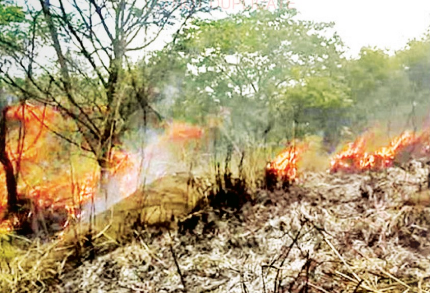 |
| (a)Burning of forests and shrubs |
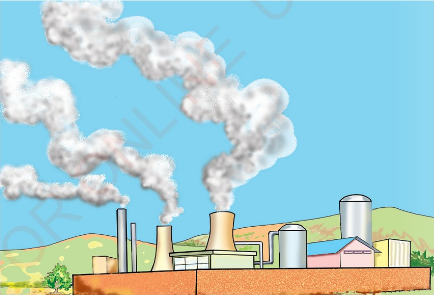 |
| (b)Industrial activities |
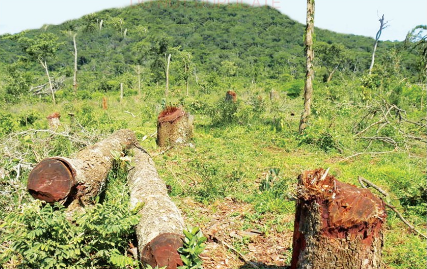 |
| (c)Deforestation |
Figure 1 : Human activities which contribute to the increase of greenhouse gases in the atmosphere
| Exercise Answer the following questions: 1. Describe how the activities shown in figure 1 can contribute to global warming. 2. What are the expected effects on the area shown in Figure 1 (c)? 3. Explain how forests can help in reducing greenhouse gases from the atmosphere? |
Through environmental destruction, human beings have played a major role in accelerating global warming and, eventually, climate change. Climate change can lead to or increase the effects of hazards on human activities and infrastructure.
A hazard is a sudden event that has the potential to cause a disaster. Hazards can be natural or man-made. Natural hazards are caused by natural forces and might have negative effects on humans and the environment. Examples of natural hazards include drought, earthquakes, floods, hurricanes or storms, volcanic eruptions, landslides and mudflows. Other hazards are caused by human influence or activities. These include accidents (on the roads, waterways, railways, airways, industries), domestic fires and forest fires. Likewise, unplanned settlements and improper solid waste disposal may cause blockage to waterways and sewage systems. This may lead to the occurrence of floods during the rainy season. Hazards may lead to disasters, causing widespread suffering in society, destruction of property, or environmental destruction. For example, severe drought may lead to food shortage, hunger, malnutrition, and deaths. Floods may seriously damage properties, infrastructure, and crops. They may also kill people and livestock.
Effects of global warmingGlobal warming has caused climate change in many areas of the world. Global warming has the following effects:
(a) Frequent recurrences of weather and climate related hazards such as drought and flooding;
(b) Frequent recurrences of storms and strong winds;
(c) Melting of snow from higher mountains and areas covered with glaciers. Figure 2 shows a decrease in the snow cover on Mount Kilimanjaro over time.
|
|
|
| (a) Mount Kilimanjaro before global warming | (b) Mount Kilimanjaro after global warming |
Figure 2: The effects of global warming on Mount Kilimanjaro
(d) The occurrence of heavy rainfall in a short time, causing floods: Global warming increases sea surface temperature, causing high evaporation to the atmosphere. Increased evaporation leads to the formation of clouds and heavy rains, which may cause floods; and
![]() Melting of ice and snow from the Earth's poles: This leads to a rise in sea level. The sea-level rise threatens settlements for the people living on islands and in coastal areas.
Melting of ice and snow from the Earth's poles: This leads to a rise in sea level. The sea-level rise threatens settlements for the people living on islands and in coastal areas.
| Exercise Answer the following question by referring figure 2 above. 1. What is the difference between the snow cover found in figure 2(a) and 2(b). 2. Explain the reasons that could cause the observed differences in the snow cover found on the mountain. . 3. How we can reduce the ongoing impacts of global warning on mount Kilimanjaro? |
Hazards associated with global warming
One of the effects of global warming is the increased frequency in occurrence of hazards such as drought and floods. A detailed explanation of these hazards and their impacts on human beings is provided below:
Drought: Drought is a prolonged period of abnormally low rainfall in a certain area. Usually, during drought, rainfall is below average. On one hand, the shortage of rainfall creates water shortage which affects human activities. On the other hand, the dry season is a normal phenomenon in a calendar year. It is one of the seasons in the year with no or very little rainfall. Drought is a serious hazard in the world. In Tanzania, drought affects regions found in central and northern zones such as Dodoma, Arusha, Manyara, Singida, Kilimanjaro, Shinyanga, and Simiyu. Drought is associated with the scarcity of water, food, and pasture for animals. In addition, during drought, there are high temperatures during the day and very low temperatures during the night, with strong winds in areas not covered with vegetation. These are due to changes in climate, which last over long periods. Therefore, the impacts of drought are usually severe.
Impacts of drought
The occurrence of drought can cause damage to people, livestock, and crops. The impacts of drought tend to be more severe due to climate change. Figure 3 shows the impacts of drought on livestock. Farmers and pastoralists are much more affected by drought.
Some of the effects of drought are as follows:
(a) Death of people and livestock due to lack of food and water;
(b) Damage of crops, which causes food scarcity;
(c) Loss of income by farmers and the government due to death of livestock and poor harvests;
(d) Destruction and erosion of the top soil by wind due to prolonged drought;
(e) Drying of water sources such as rivers, dams, wells or streams and reduced levels of water in lakes and dams;
(f) Reduced supply of hydro electric power due to low water levels in hydro electric power generating dams;
(g) Movement of wild animals to human settlements searching for pasture and water;
(h) Increased conflicts between farmers and pastoralists due to lack of water and green pasture for animals; and
(i) Occurrence and increased intensity of forest fires, threatening lives of people and animals.
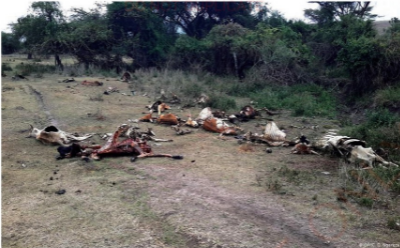 |
| Figure 3: Effects of drought on livestock in Tanzania |
| Exercise Answer the following questions: 1 . Explain the difference between a dry season and drought. 2. What is a hazard? 3. Explain the relationship between climate change and drought. |
Strategies for responding to drought
Drought is a hazard that occurs slowly. Farmers, livestock keepers, and other stakeholders can prepare and respond to drought through strategies such as the following:
(a) Planting drought-tolerant crops and short-season crops such as cassava, millet and sorghum (see Figure 4);
(b) Encouraging good farming practices to conserve soil, water, and fertility;
(c) Encouraging irrigation farming;
(d) Raising awareness of conservation agriculture, irrigation, selection of good varieties of seeds, and better usage of agricultural inputs;
(e) Encouraging modern and better ways of livestock keeping, such as reducing the number of livestock and encouraging breeds that can tolerate drought conditions;
(f) Strengthening early warning systems to provide timely and reliable information on rainfall conditions; and
(g) Preparing response plans to deal with drought.
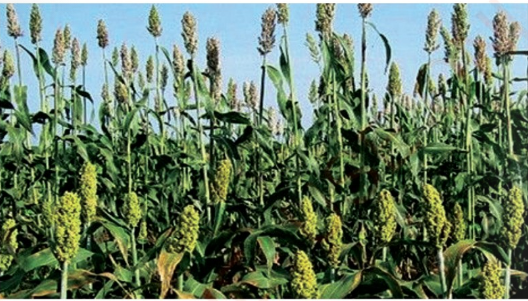 |
| Figure 4: Sorghum, one of the drought tolerant crops |
![]()
| Exercise Answer the following questions: 1. How can we respond to drought in our area? 2. What is the relationship between drought and food availability in our environment? |
Floods
Flood is a natural hazard through which a dry area is suddenly covered with water for a particular time. This hazard can lead to serious disasters, such as death of people, destruction of properties and infrastructure.
Floods occur due to several reasons. One of them is the occurrence of heavy rainfall over a long or short time. Another cause is the overflow of water from rivers, dams, lakes, and oceans. This forces water to cross or form a new way through settlements, farms, industries and business centres. Floods can occur when dams burst under pressure of water which is used for power generation or irrigation. Such dams can also burst due to technical problems.
Moreover, floods may be caused by melting of ice and snow from the north and south poles because of global warming and climate change. Global warming is also responsible for increased ocean temperatures. The rise in ocean temperature increases evaporation to the atmosphere. Continuous evaporation can lead to severe storm and hurricanes which lead to heavy rains and floods in coastal areas.
Furthermore, bad solid waste management can cause floods in our homesteads. When the environment is littered with solid waste during the rain, waste and other materials may be carried by water to waste canals and trenches. When such canals are blocked, they may cause floods during heavy rains. Figure 5 shows a blocked waste canal due to the accumulation of waste.
 |
| Figure 5: A blocked waste canal |
When water fails to find its natural passage due to blockage, it causes flooding leading to negative impacts on people, livestock, and other organisms. Floods also destroy crops and settlements. Figure 6 illustrates the impacts of floods on human settlements. Look at the pictures and answer the questions that follow.
 |
| Figure 6: Floods in human settlements |
| Exercise Answer the following questions: 1. Explain the impacts of floods. 2. How can we reduce the impacts seen in the pictures? 3. What are the causes of floods in your region? |
Flood-prone areas include low-lying areas below highlands, coastal areas, and unplanned human settlements such as the Msimbazi valley in Dar es Salaam. Other areas are those adjacent to river banks, near lakes or big dams, and areas without forests, grass or shrubs.
Impacts of floods
Floods as one of natural hazards can cause disasters. Such disasters affect the community and the environment in the following ways:
(a) Loss of human and animal lives;
(b) Destruction of infrastructure such as roads, railway lines, communication systems, water supply, and sewerage systems;
(c) Destruction of settlements and properties;
(d) Loss of properties, people, and livestock as they are washed away by floods;
(e) Destruction of crops and other plants on the land, putting the country at risk of hunger and diseases;
(f) Polluting the environment via poisonous chemicals that may get into water from mining areas, factories and human settlements; and
(g) Lack of electricity, communication, and clean water due to the destruction of infrastructure.
Strategies for reducing the impacts of floods
The impacts of floods can be prevented or reduced in a number of ways. These include the following:
(a) To avoid living in flood-prone areas such as valleys, near dams, and unplanned settlements;
(b) To ensure that the environment is always clean, for example by cleaning wastewater canals in our surroundings;
(c) To have sustainable town and city development plans in order to avoid establishing settlements in flood-prone areas;
(d) Planting grass and trees to protect the soil from water erosion; and
(e) Raising public awareness of protection against floods.
Controlling environmental destruction
The United Republic of Tanzania has taken measures to control environmental destruction and respond to disasters. The measures include establishing rules and regulations to manage the environment, encouraging environmental conservation activities, and promoting the use of alternative sources of energy.
Environmental Management Act
Tanzania enacted the Environmental Management Act number 20 of 2004. The Act prohibits activities that can destroy the environment. This is the main law for Environmental Conservation in Tanzania. The law prohibits construction along the oceans, beaches, lakes, rivers or dams. It also prohibits people from burning forests and littering water sources using any wastes and chemicals.
Other things that the Act prohibits include mining sand from beaches and diverging or blocking water from its natural course. This Act has helped in reducing environmental destruction because whoever goes against the Act is punished by the law. Examples of such penalties include paying fines, demolishing the unplanned settlements along water sources and mountains, and prosecuting those responsible for breaking the law.
Forest Act
To reduce the production of greenhouse gases, the Forest Act number 14 of 2002 controls the use of forest products and reduces forest destruction. If this law is fully implemented, it will ensure the existence of forests and reduce emission greenhouse gases.The 30% excise duty on used vehicles
In order to reduce emission of greenhouse gases from used vehicles and other pieces of equipment, the government has imposed an additional tax on non-utility vehicles which are more than 10 years old from the date of manufacture. According to the Tanzania Revenue Authority (TRA), the current tax on vehicles is 30% for vehicles older than 10 years. This law aims at encouraging people to buy newer vehicles with less negative impacts on the environment. This will reduce environmental pollution through greenhouse gases and other pollutants.
Use of alternative sources of energy
An alternative source is any source which is used instead of the primary source. Currently, firewood and charcoal are major sources of energy for cooking in Tanzania. Using alternative sources of energy reduces environmental pollution. Such alternative sources may be coal and charcoal made from remains of crops or timber. Figure 7 shows charcoal made from timber remains.
 |
| Figure 7: Charcoal made from timber remains |
This type of charcoal helps in reducing environmental pollution. The advantage of using this type of charcoal as an alternative source of energy is that it maintains environmental cleanliness and reduces deforestation. Cooking gas can also be an alternative source of energy. It is our task to encourage using alternative sources of energy and discourage using energy that pollutes the environment.
Alternative sources of energy to Hydro Electric Power (HEP)
The alternative sources of energy to hydro electric power include solar energy and natural gas. We can generate electricity using solar panels in sunny areas as well as using natural gas.
Natural gas electricity
Natural gas is harnessed from the soil and rocks through drilling and used as a fuel. Natural gas can be used to generate electricity. Such electricity can help to reduce the use of hydro electric power to generate electricity. The use of electricity from natural gas has contributed to the increase in electricity to the national grid. Figure 8 shows part of equipment for harnessing natural gas electricity.
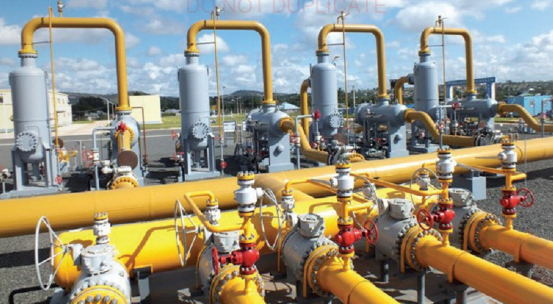 |
| Figure 8: Harnessing natural gas electricity at Kinyerezi, Dar es Salaam |
Solar Energy
Solar energy is derived from the sun. This energy can be converted into electricity. Solar energy is an alternative source of energy to generate electricity for different items such as lights, fridges, television sets, phones, and cookers. Figure 9 shows a street light that uses solar energy.
 |
| Figure 9: Street light that uses solar energy |
Atmosphere : a layer of different gases, moisture and air that surrounds the planet
Disaster : a serious disruption of the functioning of the society due to a hazardous event such as floods or drought causing negative impacts on human, property, economic or the environment
Fossil fuels : kinds of fuel formed by natural processes from remains of buried dead organisms, such as bacteria and animals
Greenhouse gases : gases that can absorb and emit energy radiation in the atmosphere: They can cause greenhouse effects, hence global warming
Hazard : a process, phenomenon, or human activity that may cause a disaster leading to death, property damage, environmental degradation, or social disruption
Humidity : amount of water vapour in the atmosphere
Infrared radiation : is a type of radiant energy that is invisible to human eyes but that we can feel as heat
Sun radiation : radiant energy emitted by the sun
Exercise
Answer the following questions:
1. Name important factors that affect the climate of Tanzania.
2. Explain human activities that contribute to global warming.
3. What strategies can be used to address the impacts of the following hazards:
(a) Floods
(b) Drought
4. Explain the impacts of deforestation in your region.
5. Explain the importance of reducing greenhouse gas emissions in our country.
Write "True" for a true statement and "False" for a false statement.
6. Hazards are caused by planting enough trees. . . . . . . . . .
7. Human activities that produce greenhouse gases are the major sources of global warming. . . . . . . .
8. The use of alternative sources of energy can minimize the rate of : environmental destruction. . . . . . . . . . .
9. Unplanned construction of houses causes floods . . . . . . . . . . . . .
10. Digging trenches and ditches for drainage water to distant places can reduce the effects of floods in our environment. . . . . . . . . . . .
www.learninghubtz.co.tz
Hub App
 For Call,Sms&WhatsApp: 255769929722 / 255754805256
For Call,Sms&WhatsApp: 255769929722 / 255754805256
 For Call,Sms&WhatsApp: 255769929722 / 255754805256
For Call,Sms&WhatsApp: 255769929722 / 255754805256
WHATSAPP US NOW FOR ANY QUERY
App Ya Learning Hub Tanzania
